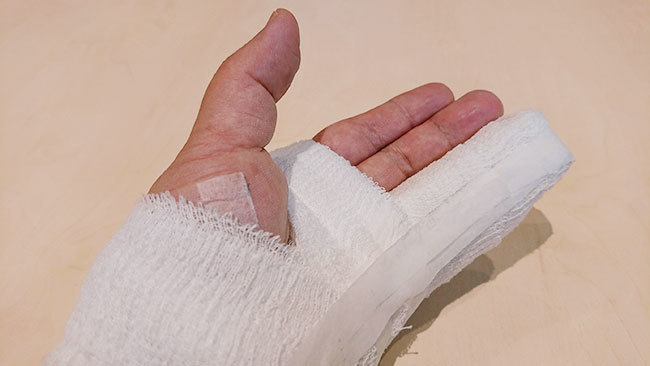
I fractured my left pinky finger. The X-ray clearly shows two distinct lines. It doesn't hurt during normal daily activities, but when I try to type with both hands, the cast keeps pressing the Shift key. Using just my right hand, I can't properly handle a knife or wash dishes.
The cause? I failed to properly return a smash (power shot) my opponent hit during tennis. Reflection, reflection—utterly embarrassing. I must learn to wield my racket, that "small shield" protecting my body, with far greater freedom and skill!!
Speaking of which, the marketing term "Target" is said to originate from the Old English words "targa" (shield) and "et" (small), meaning "small shield." As you know, this is a crucial point not only in product development but also in communication design.
Take processed foods for home use, for example. Proposals often state "target: housewives in their 30s and 40s," but is that really sufficient? Even within that group, there are diverse personalities—some want to feed their families safe food, others want convenience, and still others want to treat themselves.
So, where do you focus? You can't create a rich marketing strategy without delving beyond demographic attributes like age, gender, location, and occupation, into more psychological factors, and so on.
When you bring this up, a fair number of people respond, "Ah, you mean persona analysis." And then they might say, "Okay, let's create a persona: Makiko, a 38-year-old married woman living in Saitama City. She has two children. Her husband works in sales. She herself works part-time as a regional employee for an apparel company. She seeks a simple, natural lifestyle, so she's more interested in organic vegetables than expensive brands. That said, she's busy, so she also cleverly uses supermarket prepared foods..." And they start diligently sketching out this fictional character.

When did "persona" become so mainstream?
Upon investigation, I found that it was a concept proposed by Alan Cooper in 1998. It is a methodology that focuses on specific individuals, disliking the ambiguity of the term "user" when used in phrases such as "for the user...".
I can really relate to the idea behind it: "In order to create a product that satisfies a wide range of customers, it is more effective to design for just one person." However, when I look at the actual implementation of persona analysis in the field, it doesn't always seem to work well.
There are two main reasons for this.
According to Persona Strategy: Customer-Centric Marketing, Product Development, and Design (John S. Pruitt and Tamara Adlin, Diamond Inc.), a well-known text in this field, "Personas must be based on data. If personas are perceived as not being based on data, their credibility and practicality may be compromised." This book also introduces a process for carefully analyzing vast amounts of data.
However, most "personas" I've encountered are a composite of vague gut feelings, desires, and a smattering of data. They might generate excitement during lively group discussions, but upon later review, they're often little more than "not very useful" artifacts.
Another reason is that personas are merely one method for achieving "market-in."
In the "go-round thinking" that sparks "Oh, that's how you do it!", we encourage moving back and forth between "people" and "things/experiences" to forge new connections. It's a "third way" that isn't purely "product-out" (logically progressing from defining available technologies) or strictly "market-in" (thinking linearly from the target), but rather continuously updates hypotheses about the relationships between "people" and "things/experiences".
However, overly detailed personas hinder rapid hypothesis testing. They inevitably make us want to cling to them.
Still, though. Why the heck did "personas" become so mainstream? They've spread to every nook and cranny of Japan, no exaggeration. If people are just mimicking the surface-level act of "drawing fictional characters" without grasping the essence... what a waste, I mutter to myself.
And so, the beer flows freely once again today.
Here, have some!









